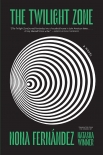The Twilight Zone Nona Fernández (e book reader for pc .TXT) 📖

- Author: Nona Fernández
Book online «The Twilight Zone Nona Fernández (e book reader for pc .TXT) 📖». Author Nona Fernández
I imagine José sees this snapshot in his mind’s eye and focuses on it that night at the Cajón del Maipo. As the man who tortured people imagined, José must be blindfolded, his hands bound, and he must be lying on the ground or perhaps standing, facing his executioners. In this last scene in the dark of the mountain night, I imagine the snapshot of the Weibel Barahonas and the sound of machine gun fire aimed at José’s back or chest.
The protective spell is broken, his body is tossed into the river, and he disappears forever.
No rescue from any distance is possible in this exercise.
Not even my runaway imagination can do a thing about that.
The opening ceremony for the Museum of Memory and Human Rights was held in January 2010. Attending were the four presidents of the Concertación, the coalition of political parties leading what analysts call the Transition, the period in which reconciliation and justice within the realm of the possible was the official stance. In those years, the decibel level of memories of violence was lowered so that a politics of consensus could be forged to keep the peace. Democracy was still in the custody of the military, with General Pinochet himself as commander in chief of the army and then a senator in Congress, so it was unwise to use the immediate past as a weapon of debate.
When I had to explain the Transition process to my son—on our first visit to the Museum of Memory, as it happens—this was how I explained it, concisely, simply, so that his young mind could understand. When I told him that the person responsible for everything he had just seen in the museum was one of the men who made the laws that governed the country, he looked at me in puzzlement and started to laugh, assuming I was kidding. At ten, my son was already wise to the bad jokes of Chilean history.
Many people were there, twenty years after democracy had been restored. Government officials, the museum’s board of directors, family members of victims, journalists, international guests, the general public, and, as I said, those four presidents of the Concertación: Patricio Aylwin (1990-1994), Eduardo Frei (1994-2000), Ricardo Lagos (2000-2006), and the sitting president, Michelle Bachelet (2006-2010). Bachelet stepped forward and took the microphone to give a heartfelt inaugural speech, opening the doors of this legitimized version of our recent memory to the audience and all of Chile. She spoke of a united country, of the hate that had once divided us, and of the need to live together in peace. And there she was, delivering an emotional speech to an equally emotional audience, when two women unexpectedly scaled one of the light towers in the courtyard where the ceremony was being held and shouted that the Concertación administrations, including all of the public figures present, had systematically violated human rights.
How is a museum of memory curated?
Who chooses what to show? Who chooses what to leave out?
The two women shouting at the opening ceremony are Ana Vergara Toledo, sister of Rafael and Eduardo Vergara Toledo, young men killed during the dictatorship, and Catalina Catrileo, sister of deceased Mapuche activist Matías Catrileo. Before the startled members of the audience, Ana pleads for justice for her dead brothers and for political prisoners, and Catalina addresses the president, saying that her brother had been killed a few years before by a national police agent during Bachelet’s own administration.
An uncomfortable moment follows. The guests watch uneasily as the president tries to address the women, who continue to challenge her from the light towers, rejecting the protocol of ceremonies, agreements, consensus, the whole notion of polite discourse that has prevailed for so many years. Ana and Catalina’s shouting begins to rouse the attendees. Memories of past and current abuses mesh, defying for a brief moment the passivity of museum displays. The women’s cries awaken memory, set it in conversation with the present, raise it from the crypt, and breathe life into it, resuscitating a creature fashioned from scraps, from bits of different people, from fragments of yesterday and today. The monster wakes and announces itself with an uncontainable howl, taking everyone by surprise, shaking those who thought they were comfortable, problematizing, conflictualizing, provoking. And this is the dangerous primal state in which it should remain. That’s what I thought when I watched a clip of what happened online, and that’s what I’m thinking today as I visit the museum yet again.
I’ve been here many times. The first time was with my son and mother right after it opened. My son ran around the wide expanse of the central courtyard while my mother looked at everything, surprised by the brightness of the place, the big windows, its resemblance to a contemporary art museum rather than a cemetery or something lugubrious and terrible, as we had imagined. Once inside, we went through the exhibits painstakingly, reading all the texts, putting on the headphones to listen to the recorded testimonies, pushing the buttons on the consoles, playing the videos, watching each screen that appeared before us.
We visited all the floors. We went into the September Eleven Zone, the Fight for Freedom Zone, the Absence and Memory Zone, the Demand for Truth and Justice Zone, the Return of Hope Zone, the Never Again Zone, the Children’s Suffering Zone. We saw the parrilla, a metal bed frame where electric current was used to shock detainees, and the door of





Comments (0)